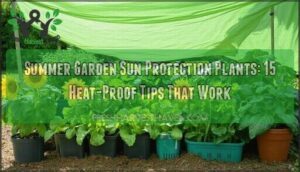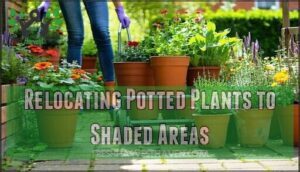This site is supported by our readers. We may earn a commission, at no cost to you, if you purchase through links.

Summer garden sun protection plants thrive when you shield them with shade cloth, which can drop temperatures by 10-15 degrees.
Install 30-50% shade fabric over tender vegetables like lettuce and spinach.
Create natural barriers using taller heat-tolerant plants like sunflowers or corn to protect shorter crops.
Apply reflective mulch around plants to bounce harsh rays away from roots.
Move potted plants to covered areas during peak afternoon hours.
Water early morning so plants can absorb moisture before heat stress kicks in.
Even the toughest gardens need smart strategies to beat the heat.
Table Of Contents
- Key Takeaways
- Protecting Plants From Sun
- Sun Protection Methods
- Heat Tolerant Plant Options
- Managing Plant Heat Stress
- Summer Garden Shade Strategies
- Frequently Asked Questions (FAQs)
- How do I protect my garden from extreme heat?
- How to shade your vegetable garden?
- What garden plants need the most sun?
- Are there any low-maintenance direct sunlight plants?
- When should I start protecting seedlings from sun?
- How do I know if my plants need shade?
- What plants recover quickly from sun damage?
- Can indoor plants get sunscald when moved outside?
- How long does plant sun acclimation typically take?
- Conclusion
Key Takeaways
- You’ll drop soil temperatures by 10-15 degrees using 30-50% shade cloth over heat-sensitive plants like lettuce and spinflowers, creating instant relief during scorching summer days.
- You can create natural cooling barriers by planting tall heat-tolerant crops like sunflowers and corn to shield shorter plants, while using reflective mulch to bounce harsh rays away from roots.
- You’ll prevent heat stress by watering early morning before temperatures peak, allowing plants to absorb moisture before the day’s heat kicks in.
- You should move potted plants to covered areas during peak afternoon hours and group plants with similar water and light needs together for easier care and better plant protection.
Protecting Plants From Sun
Summer heat can turn your thriving garden into a sun-scorched wasteland faster than you can say "heat wave."
The good news is that protecting your plants from intense sunlight doesn’t require a PhD in horticulture or a massive budget.
Using Shade Cloth Effectively
When you use shade cloth for plant shading, pick the right Shade Cloth Density for your plant-specific needs—30% for sun-lovers, up to 70% for delicate types.
Install it loosely to let air flow, and check material durability every season.
Different plants require different shade cloth options.
Good maintenance practices, like cleaning and adjusting tension, keep your sun protection strong, which means proper shade density is crucial for better plant protection.
Creating Natural Shade Barriers
While tall companion plants like sunflowers and corn create instant natural shade, you can build living walls using fast-growing vines for year-round summer garden protection.
Companion planting pairs shade-loving plants with natural shade providers perfectly.
- Train vining plants like morning glories on trellises for quick living walls
- Plant fast-growing trees strategically to create natural garden shade canopies
- Use arched walls covered with climbing beans for decorative sun protection
Utilizing Row Covers for Protection
Row covers are your garden’s secret weapon for summer sun protection. These handy sheets shield plants from harsh UV rays, keep pests at bay, and offer a bit of frost protection too.
Choose row cover materials that diffuse light and install them snugly. Many gardeners find garden row covers essential for plant health.
Here’s a quick breakdown:
| Feature | Benefit |
|---|---|
| Light diffusion | Prevents leaf burn |
| Pest control | Fewer bugs |
| UV protection | Healthier plants |
| Frost protection | Extends season |
| Easy installation | Quick setup |
The benefits of row covers include prevents leaf burn, fewer bugs, and an extension of the growing season, making them a valuable addition to any garden.
Sun Protection Methods
You can protect your plants from harsh summer sun by using shade structures, mulch, and reflective materials.
These methods help keep leaves cool, soil moist, and your garden looking less like a wilted salad on a hot day.
Setting Up Shade Structures
Beyond basic shade cloth, permanent shade structures transform your garden into a cool oasis.
Awnings and trellises create instant relief, while pergola construction offers long-term solutions.
Hoop house materials with polycarbonate panels filter harmful UV rays effectively.
Shade frame kits provide quick assembly for immediate protection.
- Awnings and trellises deliver targeted shade where you need it most
- Pergola construction creates beautiful overhead coverage for entire garden sections
- Polycarbonate panels on hoop houses block UV while allowing beneficial sunlight through
Employing Mulch for Soil Cooling
Mulch acts like a protective blanket for your garden’s root zone, keeping soil temperatures cooler during scorching summer days.
Apply a 3-4 inch layer of organic mulch types like wood chips or straw around your plants.
This soil insulation reduces heat stress while maintaining soil moisture levels.
Consider different mulch options for your garden.
Keep mulch slightly away from plant stems to prevent rot and maximize heat protection benefits.
Using Reflective Mulches for Heat Deflection
White and silver reflective mulches work like mirrors for your summer garden, bouncing heat away from plant roots instead of absorbing it.
These specialized mulches can drop soil temperatures by 10-15 degrees compared to dark organic options. Apply them 2-3 inches thick around heat-sensitive plants, keeping mulch slightly away from stems.
With rising temperatures, heat stress becomes a major concern.
While pricier upfront than regular mulch, reflective types deliver excellent cost-effectiveness through reduced watering needs and healthier plants during scorching weather, providing a significant benefit for your summer garden.
Heat Tolerant Plant Options
Looking for plants that can handle intense summer heat without wilting? These heat-loving champions actually prefer scorching temperatures and will keep your garden colorful when other plants give up.
Characteristics of Sunstar Pentas
Selecting heat-tolerant Pentas transforms your summer gardening experience with reliable blooms that thrive despite scorching temperatures.
These sun protection champions offer exceptional summer durability while attracting butterflies to your garden oasis.
Here’s what makes Sunstar Pentas perfect for heat tolerance:
- Massive flower clusters in vibrant Pentas colors like cherry red create stunning displays
- Butterfly attraction occurs naturally through nonstop blooming all season long
- Low maintenance growth requires no deadheading while standing 18-22 inches tall
These sunloving plants excel in plant sun protection strategies, delivering tropical beauty without fuss. As an added benefit, these flowers are known as the Egyptian Star Flower.
Features of Diamond Snow Euphorbia
Diamond Snow Euphorbia delivers exceptional bloom reliability with its continuous white flowers from spring until frost.
This compact powerhouse shows remarkable drought resistance and impressive heat tolerance, making it perfect for sun protection strategies in summer gardening.
You’ll appreciate its dense growth habit and abundant flower density that creates stunning displays without deadheading requirements.
It thrives with at least four hours of daily sun, showcasing its ability to perform well in various conditions.
Benefits of Suncredible Yellow Helianthus
You’ll love Suncredible Yellow Helianthus for its incredible bloom duration – it flowers continuously all season without deadheading needs.
This North American native reaches 24-36 inches in plant height while attracting pollinators with bright golden blooms.
Perfect for summer plant care, it thrives in various soil preferences and provides excellent sun protection through natural shade barriers.
Managing Plant Heat Stress
When temperatures soar, your plants need strategic protection to survive the heat without sacrificing their growth.
You can prevent heat stress by timing your watering, moving containers to cooler spots, and organizing your garden based on each plant’s specific needs to prevent heat stress.
Automating Morning Watering
Smart irrigation systems with Timer Settings save time and cut water usage by 50%.
Set your timer for cool morning temperatures when evaporation rates stay low. Your irrigation system should run before 10 AM to maximize Soil Moisture absorption.
Modern Sprinkler Types with built-in sensors adjust automatically based on weather data. This morning watering approach supports Water Conservation while keeping System Maintenance simple through app-based controls.
Relocating Potted Plants to Shaded Areas
While automated watering keeps plants hydrated, strategically moving your potted plants creates instant relief from scorching afternoon sun.
Optimal Timing matters—relocate during cooler morning or evening hours to minimize heat stress. Consider plant weight by watering when soil is slightly dry.
Moving Techniques for effective sun protection:
- Use dollies or carts for heavy containers
- Relocate to naturally shaded microclimate areas near buildings or fences
- Position under trees or large shrubs during peak heat
- Return plants to sunny spots during gentler morning light
- Post-Move Care includes checking soil moisture after relocation
Grouping Plants by Water and Light Needs
Why scatter plants randomly when strategic grouping saves time and boosts success?
Cluster garden plants with similar watering frequency and light requirements together.
This microclimate creation approach simplifies care while reducing heat stress.
Consider each plant’s growth habit and sun exposure needs.
Group shade plants separately from full-sun varieties, creating aesthetic grouping that enhances both plant growth and sun protection efficiency.
To further reduce stress, consider how mulching aids heat protection with strategic grouping and heat protection methods, including the use of mulching.
Summer Garden Shade Strategies
When summer heat threatens your garden, you can create strategic shade zones using what’s already in your landscape.
Smart positioning of water features and existing structures transforms your outdoor space into a cooling oasis that protects vulnerable plants naturally.
Positioning Water Features for Cooling
Everyone knows water features make gardens more pleasant, but strategic positioning transforms them into natural air conditioners.
Place fountains near seating areas where you’ll spend the most time to maximize evaporative cooling benefits.
Consider these ideal placement strategies:
- Position features in afternoon shade to prevent rapid water loss
- Choose areas with natural airflow to distribute cooling humidity
- Layer with tall plants to enhance the microclimate effect
Moving water creates better evaporation cooling than still ponds, making fountains ideal for hot summer days.
Utilizing Existing Landscape Features
Your yard already has perfect cooling spots waiting to be discovered. Buildings, fences, and mature trees create natural microclimates that stay 5-10°F cooler than open areas.
Position heat-sensitive plants near these existing features for effortless afternoon shade protection. As temperatures rise, understanding climate zones becomes even more essential for plant selection.
| Feature Type | Best Plant Placement |
|---|---|
| Buildings/Fences | East side for afternoon shade |
| Deciduous Trees | Under canopy for filtered light |
| Large Shrubs | North side for consistent cool zones |
| Garden Structures | Near pergolas, arbors for partial shade |
Providing Shade Cover During Heat Waves
Heat waves call for emergency shading tactics.
Set up temporary structures like shade cloth canopies or lightweight row covers during extreme temperatures.
Increase watering frequency to maintain soil hydration and create evaporative cooling around plants.
Combine reflective mulches with overhead shade for maximum sun protection when your garden needs it most.
Frequently Asked Questions (FAQs)
How do I protect my garden from extreme heat?
Like a protective umbrella shields you from rain, shade cloth creates cooling barriers that reduce temperatures by 10°F.
Use 40-70% shade cloth, apply thick mulch, move containers to shaded spots, and water during peak heat.
How to shade your vegetable garden?
Install shade cloth over hoops or frames to block 40-70% of sunlight.
Use row covers for seedlings.
Plant tall crops like corn or sunflowers to create natural shade.
Apply mulch to keep soil cool.
What garden plants need the most sun?
Tomatoes, peppers, cucumbers, squash, and sunflowers crave full sun—at least six hours daily.
If you want juicy tomatoes or tall sunflowers, give them prime real estate.
Even herbs like basil and rosemary love soaking up rays.
Are there any low-maintenance direct sunlight plants?
Yes, several plants thrive in direct sun with minimal care. Sunflowers, marigolds, zinnias, and black-eyed Susans are drought-tolerant once established. They’ll bloom all season with just occasional watering and deadheading.
When should I start protecting seedlings from sun?
Ironically, you’ll protect seedlings from sun damage when they’re most hungry for light. Start shading them immediately after transplanting outdoors, especially if they’ve been greenhouse-grown, since they lack UV tolerance.
How do I know if my plants need shade?
Watch for wilting leaves during midday heat, brown or scorched leaf edges, and plants drooping despite adequate watering.
These signs indicate your plants need shade protection to prevent further sun damage.
What plants recover quickly from sun damage?
Plants like caladiums, pentas, scaevola, and euphorbia bounce back fast from sun damage if you give them shade and water.
Keep soil moist, mulch roots, and they’ll perk up before you know it.
Can indoor plants get sunscald when moved outside?
Funny how houseplants, after a cozy life indoors, can get a rude awakening outdoors.
If you rush them into direct sun, their leaves might burn.
Ease them into sunlight gradually, like dipping your toes in chilly water.
How long does plant sun acclimation typically take?
Most plants need 7-14 days to gradually adjust to direct sunlight.
You’ll want to start with just 1-2 hours of morning sun, then slowly increase exposure daily until they’re fully acclimated.
Conclusion
Last summer, Maria’s tomato plants wilted despite daily watering until she installed 40% shade cloth over her garden beds.
Your summer garden sun protection plants strategy starts with understanding that even heat-loving crops need relief during extreme temperatures.
Combine shade structures with reflective mulch and strategic plant placement to create microclimates. Water early, move containers to protected spots, and select proven heat-tolerant varieties.
These practical techniques transform struggling gardens into thriving oases that produce abundant harvests all season long.
- https://www.provenwinners.com/learn/top-ten-lists/20-durable-plants-hot-weather
- https://mahoneysgarden.com/heat-tolerant-annuals-for-the-summer-garden/
- https://homegrownoutlet.com/shade-cloth-gardening/
- https://www.wellcowholesale.com/blog/post/5-benefits-of-using-a-shade-cloth-garden-cover-this-season
- https://www.coolaroo.com/diy-hub/the-benefits-of-keeping-a-shade-garden











